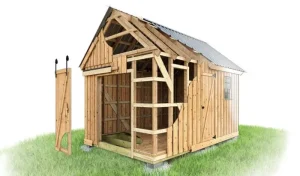Building a Backyard Shed: Essential Tools and Plans for DIY Enthusiasts
Constructing a backyard shed is a rewarding project for any DIY enthusiast. With the right plans and tools, individuals can create a functional and aesthetically pleasing structure to serve various purposes, from storage to a personal workshop. Having a well-thought-out plan and the essential tools can make the process both enjoyable and successful.
This article will explore key considerations for starting a shed project, from selecting the right materials to understanding basic construction techniques. Readers will gain insights into making informed decisions for their shed-building endeavors. Armed with the proper knowledge and setup, DIY enthusiasts are empowered to bring their vision to life.
Building a shed is not just about construction; it’s about personal achievement and creative expression. The satisfaction of completing a project with one’s own hands adds to the value the shed brings to any backyard. Whether you’re looking to tidy up your garden tools or create a cozy retreat, constructing a shed offers both practical and personal rewards.
Understanding Shed Building Fundamentals
When constructing a garden or outdoor shed, it’s crucial to focus on both the location and the intended use. Thoughtful consideration in these areas can heavily influence the outcome, ensuring that the shed not only meets practical needs but also enhances the backyard environment.
Choosing the Right Location
Selecting an appropriate spot is essential for the success of the project. The location affects accessibility, durability, and overall usability. Sheds should be positioned on level ground to prevent structural issues. It’s advisable to check local building codes and regulations, which may dictate how far the shed must be placed from property lines or other structures.
Proximity to utilities is another factor to consider. A shed used as a workshop may benefit from nearby electrical access, while a garden shed might need proximity to a water source. Lighting should also be considered. A shady spot might be preferable for a cooler environment, but sunlight can prevent excess moisture and mold growth.
Determining the Shed’s Purpose
Clarifying the intended use is vital. This involves distinguishing whether the shed will be used for storage, as a workshop, or perhaps as a place for gardening activities. Each purpose may demand different design elements, space considerations, and materials.
Storage sheds should allow for easy organization and accessibility. Tools and equipment may require shelving or racks. If used as a workshop, proper ventilation, lighting, and possibly insulation become more critical. For an outdoor garden shed, integrating features such as potting benches or seed storage can greatly enhance utility.
Designing Your Shed

When it comes to designing a backyard shed, it is essential to choose a layout that fits both aesthetic and functional requirements. Considerations include selecting a design that complements the home’s architecture and planning for the right size and storage needs to ensure all intended items fit comfortably.
Selecting a Shed Design
A well-chosen shed design is vital for both utility and appearance. Many opt for styles that match their home’s exterior, such as gable, lean-to, or saltbox. Gable sheds, with their triangular roofs, offer a classic look and increase headroom. Lean-to designs are suitable for placing against other structures, while saltbox sheds provide a unique asymmetrical roofline.
Custom shed plans are available for those needing specific features. Kits frequently include storage configurations, workbenches, or window options. It’s essential to evaluate weather conditions, as adding overhangs or high roofs can help with rain or snow load. For those in climate-vulnerable areas, materials that withstand elements ensure long-term durability.



